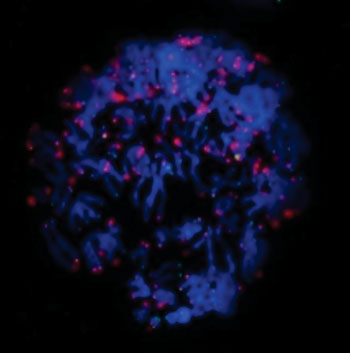Protected Telomeres Keep Precancerous Cells from Entering the Apoptotic Pathway
By LabMedica International staff writers
Posted on 09 Jul 2015
A team of molecular and cell biologists has shown that potentially cancerous cells could be eliminated from the body by rendering their telomeres more susceptible to the actions of drugs that block mitosis and direct the cells onto the apoptotic pathway. Posted on 09 Jul 2015
A telomere is a region of repetitive nucleotide sequences at each end of a chromosome, which protects the end of the chromosome from deterioration or from fusion with neighboring chromosomes. Telomere regions deter the degradation of genes near the ends of chromosomes by allowing chromosome ends to shorten, which necessarily occurs during chromosome replication. Human telomeres possess a single-stranded DNA (ssDNA) overhang of TTAGGG repeats, which can self-fold into a G-quadruplex structure. Overexpression in cancer cells of the enzyme telomerase, which adds length to telomeres, allows them to divide in perpetuity. Telomerase is activated in most human cancers and is critical for cancer cell growth.

Image: During mitosis, a cell\'s chromosomes (blue) rapidly divide. When the ends of chromosomes called telomeres (green) are no longer protected by the protein TERF2, the cell receives a signal (red) to undergo cell death (Photo courtesy of the Salk Institute).
Regular cell mitosis typically takes about 30–45 minutes, while cells about to go into mitotic crisis undergo a mitosis process that lasts 2 to 20 hours or more.
Investigators at the Salk Institute (La Jolla, CA, USA) reported in the June 24, 2015, online edition of the journal Nature that human cells in crisis underwent spontaneous mitotic arrest, resulting in death during mitosis or in the following cell cycle. This process was induced by loss of p53 function and was suppressed by telomerase overexpression.
Increasing mitotic telomere vulnerability by partial TERF2 (Telomeric repeat-binding factor 2) knockdown increased the ratio of cells that died during mitotic arrest and sensitized cancer cells to anti-mitotic drugs. TERF2, which is present at telomeres in metaphase of the cell cycle, is a second negative regulator of telomere length and plays a key role in the protective activity of telomeres.
"We set out to understand the mechanism of cell death in crisis and found a much more active role of telomeres as barriers to tumor development than previously thought," said senior author Dr. Jan Karlseder, professor of molecular and cell biology at the Salk Institute. "It started when we saw that mitosis is longer in cells approaching crisis."
"There was a long-standing hypothesis that turned out to be incorrect: that cells simply start to fuse chromosomes and break apart, generating instability and cell death," said Dr. Karlseder. "What we show instead is it a much more targeted pathway that really only takes one cell cycle to cause crisis—it has nothing to do with the slow and steady accumulation of genomic instability."
Related Links:
Salk Institute













